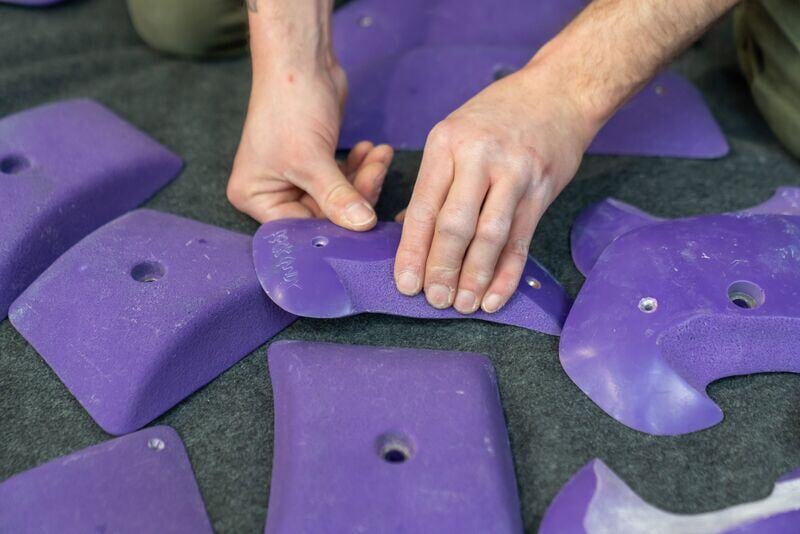From Wood to Fiberglass: The Evolution of Climbing Holds
Climbing holds are an integral part of modern indoor climbing, but they haven’t always existed in the form we know today. The evolution of climbing holds has shaped the sport in ways we often take for granted. The types of holds that were created dictate the style of movement possible, influence how climbers train, and even precipitated the development of indoor climbing as its own distinct sport. Without these innovations, indoor climbing would look vastly different than it does today.
From rudimentary training tools to the cutting-edge designs that shape contemporary routesetting, the history of climbing holds is a fascinating journey of innovation.
The Beginnings: 1970s
Before climbing holds were commercially produced, climbers just had to use what they could find. In the 1970s, indoor climbing was primarily used as a training tool for outdoor ascents. During this era, holds were primarily created from wood, molded and fired out of clay, or even carved out of natural rock. These primitive setups provided basic training but lacked the versatility and safety of modern climbing walls.
The Rise of Manufactured Holds: 1980s
The 1980s saw the introduction of the first manufactured climbing holds, primarily made from polyester resin. These holds were created by shaping foam molds and casting them in resin, providing a more uniform and comfortable texture for climbers. While this was a significant step forward, polyester resin had its drawbacks—it was heavy, prone to chipping, and emitted toxic fumes during production. Still, these early synthetic holds paved the way for further advancements in hold-making technology.
The Game Changer: 1990s
The 1990s brought a revolution with the introduction of polyurethane climbing holds. Compared to polyester resin, polyurethane was significantly lighter and much more durable. This breakthrough allowed for more intricate and ergonomic designs, mimicking natural rock formations while improving comfort and reducing injury risks. This led to the creation of the hold types we know and love today, including jugs, crimps, pockets, slopers, pinches, and more.
With ergonomics taking center stage, training became more efficient and enjoyable, allowing for climbers and setters to push the envelope on what types of moves were even possible.
The Modern Era: Innovation and Expansion
Since the 2000s, hold manufacturing has seen continuous innovation. One of the most significant developments has been the rise of hollow-back holds, reducing weight and allowing for larger shapes and more agile routesetting.
Another breakthrough came with fiberglass holds, which are even lighter than traditional polyurethane holds. These features enable dramatic changes to wall terrain and can even be modular, allowing for even more unique formations. These developments have allowed setters to craft dynamic, “comp-style” moves on aesthetically eye-catching boulders.
Manufacturers have also pushed creative boundaries, designing experimental holds that go beyond nature-inspired shapes. From bubble wrap and pie crust textures to lightbulb- and baby head-shaped holds, the possibilities are nearly limitless. Dual-texture (or dual tex for short) holds—which combine slick, non-textured surfaces with grippy sections—have become a staple for commercial gyms and competition climbing alike. Now, the latest innovation includes no-tex holds, an invention that has elicited mixed reactions and provided a brand-new challenge.
Holds and the Evolution of Climbing Movement
As holds have advanced, so has the sport of climbing itself. With early advances in ergonomics, climbers could train longer without excessive wear on their skin. As the variety and styles of holds have increased routesetters have also been able to push movement, allowing for the rise of more dynamic and creative moves. The emergence of more hold types has also seen the emergence of new moves, from laches to paddle dynos, and other coordination moves. Indoor climbing has become a sport in its own right, no longer just a training ground for the outdoors.
The Future of Climbing Holds
As technology continues to evolve, we can expect even more groundbreaking innovations in hold design. Whether through new shapes and materials or more sustainable manufacturing methods, the future of climbing holds remains an exciting frontier.
Next time you're at the climbing gym, take a moment to appreciate the holds beneath your hands. Each one represents decades of progress, experimentation, and passion for climbing. As the sport continues to evolve, who knows what new shapes and challenges will appear on our walls next?

